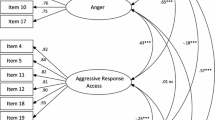Abstract
Behaviors of influence and response during a conflict negotiation task were examined in eight physically child abusing, substance abusing families in which the father was the primary abuser and eight demographically matched nonabusing families. Abusing fathers displayed more coercive patterns of influencing behavior and more negative patterns of response to other family members, including both mothers and children. Fewer differences were observed between mothers in the abusing and nonabusing families or in the children's behavior; however, mothers in the abusing families criticized their husbands more and abused children exhibited less agreement and more criticism toward their fathers. In support of Patterson's theory, abusing families exhibited relatively more reciprocated sequences of criticism and relatively fewer reciprocated sequences of agreement as compared to nonabusing families. Findings are discussed in terms of their implications for understanding interaction in child abusing families.
Similar content being viewed by others
References
Baunlin, P., and Schwartz, R. (1986). Sequences: Toward a common denominator of family therapy.Fam. Proc. 25.
Bermann, E. (1973).Scapegoat, University of Michigan Press, Ann Arbor, MI.
Burgess, R., and Conger, R. (1978). Family interaction in abusive, neglectful and normal families.Child Devel. 49: 1163–1173.
Cantrell, P., Carrico, M., Franklin, J., and Grubb, H. (1990). Violent tactics in family conflict relative to familial and economic factors.Psychol. Rep. 66: 823–8.
Crittenden, P. (1983). Abusing, neglecting, problematic and adequate dyads: Differentiating by patterns of interaction.Merrill-Palmer Quart. 27: 201–218.
Dell, P. (1982). Beyond homeostasis: Towards a concept of coherence.Fam. Proc. 21.
Diaz, R., Neal, C., and Vachio, A. (1991). Maternal teaching in the zone of proximal development: A comparison of low and high-risk dyads.Merrill-Palmer Quart. 37: 83–107.
Giovannoni, J., and Becerra, P. (1979).Defining. Child Abuse, Free Press, New York.
Hartmann, D. (1977). Considerations in the choice of interobserver reliability estimates.J. Appl. Behav. Anal. 10: 105–116.
Hollingshead, A. B. (1975). Four factor index of social status. Unpublished manuscript, Yale University, Department of Sociology.
Lyons-Ruth, K., Connell, D., Zoll, D., and Stahl, J. (1987). Infants at social risk: Relations among infant maltreatment, maternal behavior, and infant attachment behavior.Devel. Psychol. 23: 223–232.
Mash, E. J., Johnston, C., and Kovitz, K. (1983). A comparison of the mother-child interactions of physically abused and non-abused children during play and task situations.J. Clin. Child Psychol. 12: 337–346.
Patterson, G. (1982).Coercive Family Process, Castalia Publishing, Eugene, OR.
Reid, J. (1986). Social interactional processes in families of abused and nonabused children. In Zahn-Waxler, C., Cummings, E. M., and Iannotti, R. (eds.),Altruism and Aggression, Cambridge University Press, Cambridge.
Steinberg, L., Catalano, R., and Dooley, D. (1981). Economic antecedents of child abuse and neglect.Child Devel. 52: 975–985.
Wauchope, B. A., and Straus, M. A. (1987, July 6–9). Age, class, and gender differences in physical punishment and physical abuse of American children. Paper presented at the Third National Conference on Family Violence Research, University of New Hampshire, Durham, NH.
Wilson, M., Daly, M., and Weghorst, S. (1980). Household composition and the risk of household abuse and neglect.J. Biosocial Sci. 12: 333–340.
Author information
Authors and Affiliations
Rights and permissions
About this article
Cite this article
Silber, S., Hermann, E., Henderson, M. et al. Patterns of influence and response in abusing and nonabusing families. J Fam Viol 8, 27–38 (1993). https://doi.org/10.1007/BF00986991
Issue Date:
DOI: https://doi.org/10.1007/BF00986991




